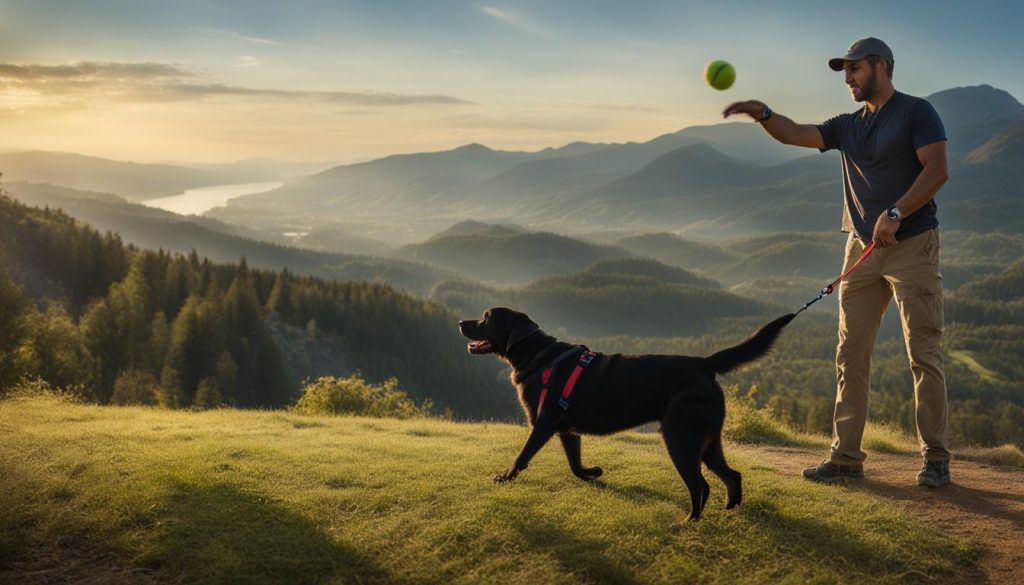When it comes to traveling with your furry friend, ensuring their safety, obedience, and good behavior is of utmost importance. One way to achieve this is by teaching your dog essential commands before embarking on your journey. By training them to follow these commands, you can address behavior problems, maintain control, and prevent any unwanted incidents.
Through extensive research and consultation with experts, I have compiled a list of helpful commands that every dog should learn before traveling. These commands will not only make your travel experience smoother but also strengthen the bond between you and your canine companion.
Key Takeaways:
- Teaching your dog basic commands is essential for a hassle-free and safe journey when traveling together.
- Basic dog commands establish structure, discipline, and obedience, ensuring your dog’s safety and well-being.
- The “sit” and “stay” commands promote calmness and control, while the “come” and “lay down” commands are useful for recall and managing excitability.
- The “stay” and “leave it” commands provide convenience and prevent your dog from grabbing or eating potentially dangerous items.
- The “recall” and “heel” commands are crucial for off-leash exploration and well-behaved walks.
The Importance of Basic Dog Commands
When it comes to training your dog, basic commands play a crucial role in establishing discipline, structure, and communication. By teaching your dog essential commands, you are laying the foundation for a well-behaved and obedient travel companion. Not only do these commands ensure your dog’s safety and well-being during travel, but they also prevent behavior issues and strengthen the bond between you and your furry friend.
Basic dog commands such as sit, stay, come, and leave it are essential for a hassle-free journey. The “sit” command promotes calmness and control, allowing you to manage your dog’s behavior in various situations. The “stay” command helps your dog stay in one place, providing convenience and safety, especially when you need them to remain stationary during travel.
Teaching your dog the “come” command is crucial for their safety, as it allows you to call them back to you in potentially dangerous situations. The “leave it” command is equally important as it prevents your dog from picking up or consuming something harmful while exploring new environments.
The Importance of Basic Dog Commands
Basic dog commands serve as the building blocks for a well-trained and obedient dog. They establish trust, respect, and a clear line of communication between you and your furry companion. By starting early and consistently practicing these commands, you are not only ensuring your dog’s safety but also improving their focus and responsiveness.
During travel, dogs may encounter new and unfamiliar environments, which can be overwhelming for them. By teaching them basic commands, you help them navigate these situations with ease and reduce their anxiety. Additionally, practicing these commands regularly strengthens the bond between you and your dog, creating a harmonious and enjoyable travel experience for both of you.
To put it simply, dog obedience training is an ongoing process, and consistency is key. Practice these basic commands in different settings and gradually increase distractions to ensure your dog’s obedience remains strong even in challenging situations. With time, patience, and positive reinforcement, your dog will become a well-behaved and reliable travel companion.
Teaching Your Dog to Sit and Stay
When it comes to training your dog, one of the most important commands to teach is the “sit” command. Not only does it promote calmness and control, but it also serves as the foundation for many other commands. To teach your dog to sit, start by holding a treat close to their nose and slowly raising it up while saying “sit.” As their head follows the treat, their bottom will naturally lower into a sitting position. Once they are seated, reward them with the treat and plenty of praise. Consistency is key, so repeat this process multiple times until they understand the command.
Once your dog has mastered the “sit” command, you can move on to teaching them to “stay.” This command is particularly useful during travel as it helps keep your dog in one place, whether you’re in a busy airport or at a campground. To teach your dog to stay, give the “sit” command first. Then, while facing your dog with an open palm, say “stay” in a firm but gentle tone. Take a step back and wait a few seconds before returning to your dog and rewarding them with a treat. Gradually increase the duration and distance before rewarding them, ensuring that they can maintain the stay command even in distracting environments.
Understanding the Benefits
Learning the “sit” and “stay” commands can have numerous benefits for both you and your dog. Firstly, it establishes a sense of obedience and control, which is essential for keeping your dog safe during travel. By having your dog sit and stay when necessary, you can prevent them from running off or getting into potentially dangerous situations. Additionally, these commands promote good behavior, as your dog will learn to wait patiently and calmly instead of jumping or lunging at people or other animals they encounter. Lastly, teaching your dog to sit and stay can enhance their focus and responsiveness to your commands, making the travel experience more enjoyable for both of you.
Table: Sit and Stay Command Training Schedule
| Week | Training Steps |
|---|---|
| 1 | Introduce the “sit” command and practice daily for short durations |
| 2 | Continue practicing the “sit” command, gradually increasing the duration of sitting |
| 3 | Introduce the “stay” command after the dog has mastered sitting |
| 4 | Practice the “stay” command with short distances, gradually increasing the distance and duration |
| 5 | Practice the “sit” and “stay” commands in different environments and with distractions |

“Training your dog to sit and stay is crucial for their safety and well-being during travel. By mastering these commands, you can establish obedience, prevent behavior issues, and enhance your bond with your furry companion. Try to be patient, consistent, and reward your dog for their efforts. With time and practice, your dog will become a well-behaved travel companion.”
By teaching your dog to sit and stay, you are setting them up for success in various travel situations. These foundational commands provide you with a greater level of control over your dog’s behavior and ensure their safety while on the go. To put it simply, training takes time and patience, so be sure to practice these commands regularly and reinforce positive behavior with rewards and praise. With consistent training and positive reinforcement, your dog will become a well-behaved and obedient travel companion.
Teaching Your Dog to Come and Lay Down
When it comes to teaching your dog essential commands for travel, two important ones to focus on are “come” and “lay down.” The “come” command is crucial for keeping your dog safe and in your control, especially in unfamiliar environments. By teaching your dog to come when called, you can prevent them from getting into potentially dangerous situations or straying too far away.
To teach your dog to come on command, start by using a leash and collar for better control. Call your dog’s name in an enthusiastic tone, followed by the word “come.” Gently pull on the leash to guide your dog towards you, and reward them with praise, affection, and treats when they reach you. Consistency and positive reinforcement will help your dog understand and respond to the “come” command consistently.
The “lay down” command is another useful command that promotes calmness and control in various situations. It can be particularly helpful during travel to prevent your dog from jumping on guests or becoming overly excited. To teach your dog to lay down, hold a treat close to their nose and then slowly guide their body towards the ground while saying “down.” Once your dog is in the down position, reward them with praise and treats. With practice and repetition, your dog will learn to associate the verbal cue “down” with the action of laying down.
Example Table:
| Command | Steps to Teach |
|---|---|
| Come |
|
| Lay Down |
|
To put it simply, consistency, patience, and positive reinforcement are key when teaching these commands to your dog. Practice in various environments to ensure your dog understands and responds to the commands reliably, even in distracting situations. With these commands mastered, you can have better control over your dog while traveling and ensure a safe and enjoyable experience for both of you.

Teaching Your Dog to Stay and Leave It
When it comes to traveling with your dog, two essential commands that you should teach them are “stay” and “leave it.” These commands are crucial for their safety and your peace of mind. By mastering these commands, you can ensure that your dog remains obedient and avoids potentially dangerous situations.
The “stay” command is particularly useful in various scenarios, such as when you need your dog to stay in one place while you handle luggage or when you want them to wait patiently during meal times. To teach your dog to stay, start by ensuring that they are proficient with the “sit” command. Once they have mastered sitting, gradually introduce the “stay” command by increasing the distance and duration before rewarding them when they successfully stay in place.
The “leave it” command is essential for preventing your dog from picking up or consuming harmful objects, especially during travel when unfamiliar environments can pose risks. To teach your dog to leave it, hold a treat in your closed fist and say “leave it” in a firm but gentle tone. Reward them when they ignore the treat and focus on you instead. Repeat this exercise regularly to reinforce the command and protect your dog from potential hazards.
| Command | Instructions |
|---|---|
| Stay | – Ensure proficiency with the “sit” command – Gradually increase distance and duration – Reward for successful stays |
| Leave It | – Hold a treat in closed fist – Say “leave it” in a firm but gentle tone – Reward for ignoring the treat |
To put it simply, consistency and positive reinforcement are key when training your dog. Practice these commands regularly and provide rewards, such as treats or praise, to reinforce their behavior. With time and patience, your dog will become well-versed in staying and leaving items, ensuring a safer and more enjoyable travel experience for both of you.
Training your dog to stay and leave it is crucial for their safety during travel. By teaching them these commands, you can prevent unwanted behavior and protect them from potential hazards.
Teaching Your Dog Recall and Heel
When it comes to training your dog for travel, two important commands to focus on are recall and heel. These commands provide safety, control, and convenience during off-leash exploration and on-leash walks. By teaching your dog recall and heel, you can ensure a well-behaved and obedient travel companion.
Teaching Your Dog Recall
The recall command is crucial for keeping your dog safe and preventing them from wandering off or getting into dangerous situations. To teach your dog recall, start by calling their name in a happy and enthusiastic tone, followed by the command “come.” Use positive reinforcement such as treats, praise, and affection when they respond and come back to you. Practice in a controlled environment first before gradually increasing distractions and distance.
Teaching Your Dog to Heel
The heel command is essential for enjoyable and controlled walks when traveling. It teaches your dog to walk calmly beside you without pulling or lunging. To teach your dog to heel, start with a loose leash and a treat in your hand. Hold the treat close to your leg, and as your dog walks beside you, reward them with the treat and praise. Consistency and repetition are key in reinforcing the behavior. Gradually increase the duration and distance of walking beside you without pulling.
| Recall Command | Heel Command |
|---|---|
| Call your dog’s name | Hold the treat close to your leg |
| Use a happy and enthusiastic tone | As your dog walks beside you, reward with a treat |
| Say “come” | Provide praise and affection |
| Use positive reinforcement (treats, praise, affection) | Practice in a controlled environment |
| Gradually increase distractions and distance | Be consistent and repeat the command |
To put it simply, training your dog for recall and heel requires patience, consistency, and positive reinforcement. Celebrate their successes and be understanding of any setbacks along the way. With practice and dedication, you can have a dog that reliably comes when called and walks calmly by your side, making travel experiences more enjoyable for both of you.

Teaching Your Dog to Drop It and Wait
When it comes to ensuring your dog’s safety and preventing them from getting into trouble, two essential commands to teach them are “drop it” and “wait.” The “drop it” command is particularly crucial for situations where your dog picks up something potentially dangerous or harmful. By teaching them this command, you can protect them from ingesting or playing with hazardous objects.
To teach your dog to “drop it,” start by offering them a toy or object that they enjoy playing with. Once they have it in their mouth, say “drop it” in a firm but gentle tone. Encourage them to release the object by holding a treat in front of their nose and rewarding them when they let go. Repeat this process consistently, gradually phasing out the treat rewards as they become more proficient.
The “wait” command is essential for preventing your dog from rushing out of doors or gates, providing an added layer of safety during travel. To teach them to “wait,” hold your hand up in a stop gesture and say “wait” in a clear and commanding tone. Make sure your dog understands that they should stay in place until you give them the signal to proceed. Reward them for staying put, gradually increasing the duration and distance over time.
Using Positive Reinforcement
Both the “drop it” and “wait” commands can be effectively taught using positive reinforcement techniques. Positive reinforcement involves rewarding your dog with treats, praise, or affection when they exhibit the desired behavior. By associating the commands with positive experiences, your dog will be more motivated to follow them consistently.
Try to be patient and consistent in your training efforts. Practice these commands in various environments and situations, gradually increasing distractions to ensure that your dog can obey them even in challenging circumstances. With time and dedication, your dog will learn to “drop it” and “wait” reliably, making them a well-behaved travel companion.

| Command | Steps |
|---|---|
| Drop It |
|
| Wait |
|
Additional Commands for Fun and Interaction
While teaching your dog essential commands is crucial for their safety and obedience during travel, it’s also important to incorporate some fun and interactive commands into their training regimen. These commands not only provide mental stimulation for your dog but also enhance the bond between the two of you. Here are some additional commands that you can teach your dog for a playful and enjoyable experience:
“Speak” command: This command teaches your dog to bark on cue. It can be a fun trick to show off and entertain others.
“Quiet” command: The “quiet” command is the perfect follow-up to the “speak” command. It teaches your dog to stop barking on cue, ensuring peace and tranquility when needed.
“Shake hands” command: This command teaches your dog to extend their paw for a handshake. It’s a delightful trick that can impress your friends and family.
“High-five” command: Similar to the “shake hands” command, the “high-five” command teaches your dog to raise their paw and give you a high-five. It’s a fun way to interact and bond with your furry friend.
“Roll over” command: The “roll over” command teaches your dog to lie down and roll onto their back. It’s a cute and entertaining trick that can bring lots of joy and laughter.
Teaching these fun commands can be done using positive reinforcement, such as treats and praise. Try to be patient and consistent with your training sessions. Incorporating these commands into your dog’s repertoire will not only provide entertainment but also keep their minds sharp and engaged.

Final Thoughts
As a professional dog trainer, I cannot stress enough the importance of teaching your dog essential commands before embarking on any travels. These commands, such as sit, stay, come, and leave it, are the foundation of a well-behaved and obedient travel companion.
By investing time and effort into training your dog in these basic commands, you can ensure their safety, prevent behavior issues, and strengthen the bond between you and your furry friend. Try to be patient, consistent, and always use positive reinforcement throughout the training process.
So, whether you’re planning a road trip, a beach vacation, or a hike in the mountains, make sure your dog is well-prepared by mastering these helpful commands. With their obedience and good behavior, you will have a stress-free and enjoyable journey together. Happy travels!
FAQ
What are some essential commands that my dog should learn before traveling?
Some essential commands that your dog should learn before traveling include sit, stay, come, leave it, recall, heel, drop it, and wait. These commands will ensure your dog’s obedience, prevent behavior issues, and enhance their safety and well-being during travel.
How do I teach my dog to sit and stay?
To teach your dog to sit, hold a treat close to their nose and guide their head up while saying “sit.” Once they sit, reward them with a treat and affection. To teach them to stay, start by ensuring they are proficient with the sit command. Then, gradually increase the duration and distance before rewarding them for staying in place.
What is the best way to teach my dog to come and lay down?
To teach your dog to come, use a leash and collar and gently pull the leash towards you while saying “come.” Reward them with treats and affection when they come to you. To teach them to lay down, guide their body to follow their head with a treat, say “down,” and reward them when they lay down.
How can I teach my dog to stay and leave it?
To teach your dog to stay, start by ensuring they are proficient with the sit command. Then, gradually increase the duration and distance before rewarding them for staying in place. To teach them to leave it, hold a treat in your closed fist, say “leave it,” and reward them when they ignore the treat.
What are the commands for recall and heel?
The recall command involves calling your dog’s name followed by “come” and rewarding them when they return to you. The heel command teaches your dog to walk calmly beside you without pulling or lunging. Use treats or a clicker to get their attention, reward them for walking by your side, and consistently reinforce the behavior.
How do I teach my dog to drop it and wait?
To teach your dog to drop it, offer them a toy or object, say “drop it” in a firm but gentle tone, and reward them when they release the object willingly. To teach them to wait, hold your hand up and say “wait,” reward them for staying in place, and gradually increase the duration and distance.
Are there any additional commands for fun and interaction?
Yes, there are several fun commands you can teach your dog, including “speak,” “quiet,” “shake hands,” “high-five,” and “roll over.” These commands can be taught using positive reinforcement and repetition, providing mental stimulation and strengthening your bond with your dog.
Why is training my dog in basic commands important before traveling?
Training your dog in basic commands before traveling is crucial for a hassle-free and safe journey. By teaching them commands such as sit, stay, come, and leave it, you can ensure their obedience, prevent behavior issues, and strengthen your bond. Consistency, patience, and positive reinforcement are key throughout the training process.






